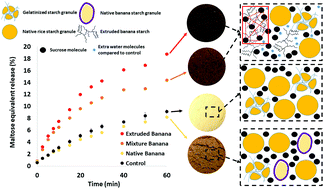Nutritional and physical characterization of sugar-snap cookies: effect of banana starch in native and molten states
Abstract
Starch is the major glycemic carbohydrate related to postprandial glycaemia and it naturally exists in the form of partially crystalline starch granules. Interestingly, the microstructural and granular features of banana starch have been reported to be inherently resistant to enzyme digestion. Converse to bread, sugar-snap cookie dough undergoes minimum starch gelatinization during baking. Therefore, the inclusion of banana starch in sugar-snap cookies could have a major role on starch susceptibility to be undigested or digested slowly, which could be especially relevant in gluten-free diets, typically characterized by a lower fiber intake and higher glycemic response. Here, we demonstrate that the starch digestion rate (k) and consumer's acceptance of gluten-free sugar-snap cookies can be simultaneously improved by a 30% replacement of rice flour by native banana starch. Furthermore, the content of resistant starch was increased from 0.1 to 3.6% (g per 100 g cookie), which would allow labeling of cookies as “source of fiber” in some food regulations. We also showed that the inclusion of fully gelatinized banana starch causes an increase of the water fraction that dramatically shifts the texture from brittle to soggy, according to the three-point bending test, that contributed to worsen consumer's acceptance. Classic sugar-snap cookies are composed mainly of a continuous glassy sucrose–water matrix which confers this product its brittle textural properties. Therefore, when selecting novel starches for low/sustained glycemic response, it is paramount to deliberately formulate sugar-snap cookies to begin their shelf-lives in a glassy state that allows a desired crispy texture.



 Please wait while we load your content...
Please wait while we load your content...